Nederlandse Modelbouw en Luchtvaartsite
Dutch Modelling and Aviation
Airspeed AS-10 Oxford Mk.II
Page 2 of 7
In service with RAF, RNlAF and RNlNAS.
In service with Dutch Communications Flight RAF and 320 squadron RAF.
The Oxford was used by the RAF as crew trainer for navigation and bomber crews.
Later several were used for light transport- and communication services. No. 1316 (Dutch) Communications Flight used several Oxfords during the last year of the Second World War .
Also about three Oxfords were in use with no. 320 Dutch squadron, mainly for training and liaison purposes.
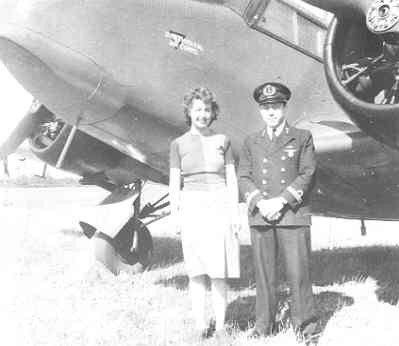
Airspeed Oxford of Royal Netherlands Naval Air Communications Flight.
[Enclosed photo from BeeldBank NIMH. Click on photo for ordering information]
[Enclosed photo from BeeldBank NIMH. Click on photo for ordering information]
In service with RNlAF.
The Oxfords were assigned to the AVOT, the additional twin-engine pilot training at Twenthe. They were also used for the training of pilots of the Gloster Meteor. In 1950 they were succeeded by the Beechcraft AT-7 Navigator.
According to J.M. van Hest, in an article in Hobby Bulletin of May 1971, were he states the C-1 through C-14 were of type Oxford Mk. II and C-15 through C-28 of type Mk. V.
C. van den Heuvel, who has researched and written an book about aircraft in use by the post-war Royal Netherlands Air Force, states that all Oxfords were of the Mk. I version. Personally I subscribe this point of view.
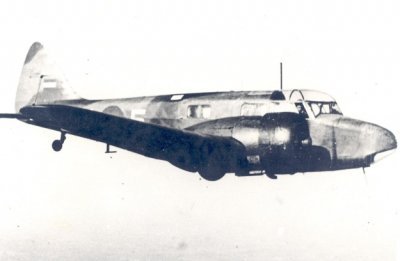
In flight photo of Airspeed AS-10 Oxford, C-5.
[Enclosed photo from BeeldBank NIMH. Click on photo for ordering information]
[Enclosed photo from BeeldBank NIMH. Click on photo for ordering information]
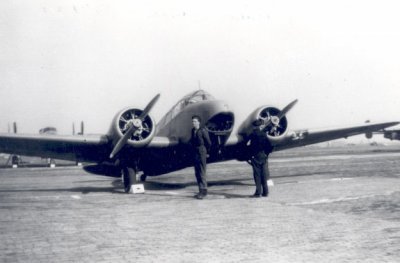
An Airspeed AS-10 Oxford at Valkenburg.
[Enclosed photo from BeeldBank NIMH. Click on photo for ordering information]
[Enclosed photo from BeeldBank NIMH. Click on photo for ordering information]

Two officers in front of an Airspeed AS-10 Oxford.
[Enclosed photo from BeeldBank NIMH. Click on photo for ordering information]
[Enclosed photo from BeeldBank NIMH. Click on photo for ordering information]

An Airspeed AS-10 Oxford in a hangar.
[Enclosed photo from BeeldBank NIMH. Click on photo for ordering information]
[Enclosed photo from BeeldBank NIMH. Click on photo for ordering information]
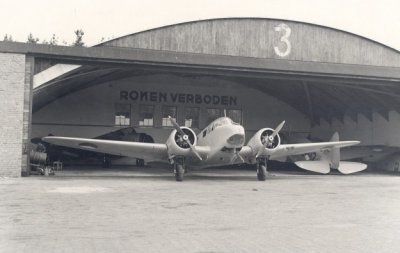
Airspeed AS-10 Oxford, overall yellow paint scheme in front of hangar 3.
[Enclosed photo from BeeldBank NIMH. Click on photo for ordering information]
[Enclosed photo from BeeldBank NIMH. Click on photo for ordering information]

Line-up of Airspeed AS-10 Oxfords, possibly shortly after delivery, regarding the names on the nose and the (barely visible) RAF fin flash on the tail of the second Oxford.
[Enclosed photo from BeeldBank NIMH. Click on photo for ordering information]
[Enclosed photo from BeeldBank NIMH. Click on photo for ordering information]

Airspeed AS-10 Oxford.
[Enclosed photo from BeeldBank NIMH. Click on photo for ordering information]
[Enclosed photo from BeeldBank NIMH. Click on photo for ordering information]
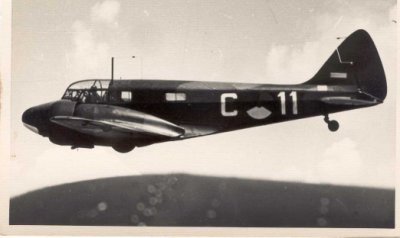
Airspeed AS-10 Oxford, C-11.
[Enclosed photo from BeeldBank NIMH. Click on photo for ordering information]
[Enclosed photo from BeeldBank NIMH. Click on photo for ordering information]
In service with RNlNAS.
In September 1945 the minister of Naval Affairs discussed the acquisition of three aircraft (including equipment and spare parts) for performing communication flights.
Early 1946, three aircraft were received on loan. These were brought in the so-called detachment aircraft carriers, VKS. This detachment was based on airbase Heston, Middlesex, as section squadron no 701. There were regularly conducted flights to Valkenburg, Eindhoven and Schiphol.
From July 1946 it is stated that three Oxford would have been purchased by the RNlAS. These aircraft originated from the Admiralty Communications Flight, Royal Navy.
These aircraft were stationed on airbase Valkenburg in May 1947 and were used as liaison aircraft and also for photo flights.
Soon they were transferred to 320 Squadron for "general purpose" and got the new serials A-1 to A-3. When this happened is not known. With the commissioning of the squadron 5, early 1951 the Oxford were housed there. Also was their registration changed in R.1 through R3 and during the course of 1951 the R-4 and R-5 (received from the LSK) were added to the strength. These last two Oxfords were written off in 1952, due to poor condition.
In 1953, the remaining aircraft were replaced by the Beechcraft SNB-5/TC-45J Navigator.

Airspeed AS-10 Oxford of RNlNAS.
[Enclosed photo from BeeldBank NIMH. Click on photo for ordering information]
[Enclosed photo from BeeldBank NIMH. Click on photo for ordering information]
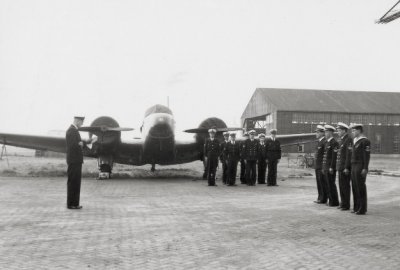
Airspeed Oxford Mk.I trainer, A-1 (1947-1952) with the entire crew
[Enclosed photo from BeeldBank NIMH. Click on photo for ordering information]
[Enclosed photo from BeeldBank NIMH. Click on photo for ordering information]
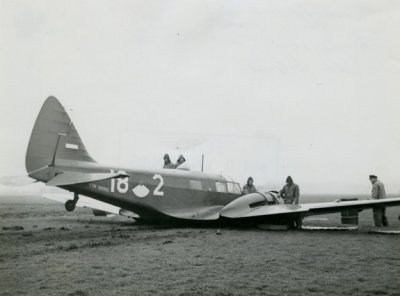
Emergency landing of Oxford, 18-2 near Wassenaar in 1951.
[Enclosed photo from BeeldBank NIMH. Click on photo for ordering information]
[Enclosed photo from BeeldBank NIMH. Click on photo for ordering information]

Airspeed Trainer of the RNlNAS (1947-1953).
[Enclosed photo from BeeldBank NIMH. Click on photo for ordering information]
[Enclosed photo from BeeldBank NIMH. Click on photo for ordering information]
